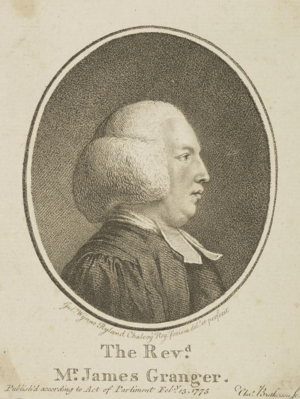James Granger facts for kids
Quick facts for kids
James Granger
|
|
|---|---|
 |
|
| Born | 1723 |
| Died | 1776 |
| Occupation | English clergyman, writer |
James Granger (1723–1776) was an English clergyman (a type of religious leader), writer, and collector of old pictures. He is best known for his book, Biographical History of England from Egbert the Great to the Revolution (1769). Granger was also one of the first people to speak up for animal rights.
Contents
Life and Work
James Granger was born in Shaftesbury, Dorset, in 1723. His parents were not wealthy. He went to Christ Church, Oxford university in 1743 but left without finishing his degree.
After becoming a clergyman, he worked as a vicar in Shiplake, Oxfordshire. He lived a quiet life there. Some people, like the famous writer Samuel Johnson, didn't like his political ideas.
While working on his Biographical History, Granger wrote to many people who collected old pictures and studied English history. In 1773 or 1774, he traveled to Holland with Lord Mountstuart, who collected many portraits there.
Granger died suddenly on April 15, 1776. He had been leading a church service the day before when he became ill.
He owned a large collection of over 14,000 engraved portraits (pictures made from engravings). These were sold after his death in 1778.
The Impact of His Book
Before Granger's book came out in 1769, old English portraits were not very expensive. But after his Biographical History was published, books with engraved portraits became much more valuable. Many old books were even cut up just to get the pictures inside them!
People started collecting and adding portraits to copies of Granger's book. For example, in 1856, one copy of his work with over 1,300 portraits was sold for £42. Another copy with more than 3,000 portraits was sold for £38 10s, even though it had cost the owner almost £200 to create.
Many collections of portraits were published to go along with Granger's book. These included 'Richardson's Collection' (1792–1812) and Samuel Woodburn's 'Gallery of Portraits' (1816).
Extra-Illustration: "Grangerising" Books

Extra-illustration is a special way of customizing books. It involves adding drawings, prints, and other pictures into a printed book. This was often done with books about the history of a town, a county, or a famous person.
This process is often called "Grangerising" or "Grangerization." These terms became popular in the 1880s, which was more than 100 years after Granger died. It's funny because Granger himself never "grangerized" a book!
There are many famous examples of extra-illustrated books, especially copies of Granger's Biographical History. One of the most important was made by Richard Bull. It has over 14,000 prints and fills 36 volumes! Another example was created by Bristol antiquarian (someone who studies old things) George Weare Braikenridge. He added nearly 4,000 portraits to his copy of the Biographical History.
Advocacy for Animal Rights
In 1772, James Granger gave a sermon (a religious speech) where he spoke out against being cruel to animals. At that time, talking about treating animals kindly was not a common topic for church sermons. Some people thought it was not a proper subject for a clergyman to discuss. Granger faced difficulties for his strong beliefs on this topic.
His sermon was later published as a book called An Apology for the Brute Creation (1772). At first, it wasn't very popular, but it received good reviews from some important magazines. This sermon later influenced Arthur Broome, who helped start the Society for the Prevention of Cruelty to Animals (RSPCA). This organization works to protect animals from harm.
Notable Works
Here are some of James Granger's important writings:
- Biographical History of England, from Egbert the Great to the Revolution (1769): This was his most famous work. It was a history of England that focused on famous people and included a list of engraved portraits. It helped people learn about history through pictures. The book was updated and reprinted many times.
- An Apology for the Brute Creation, or Abuse of Animals censured (1772): This was his sermon arguing against cruelty to animals.
- The Nature and Extent of Industry (1775): This was another sermon he gave. He dedicated it to the people of his parish who didn't attend church, hoping they might read it even if they didn't hear it.
- Letters between the Rev. James Granger, M.A. [sic], and many of the most eminent Literary Men of his time (1805): This book collected letters Granger wrote to other important writers and thinkers of his time.

